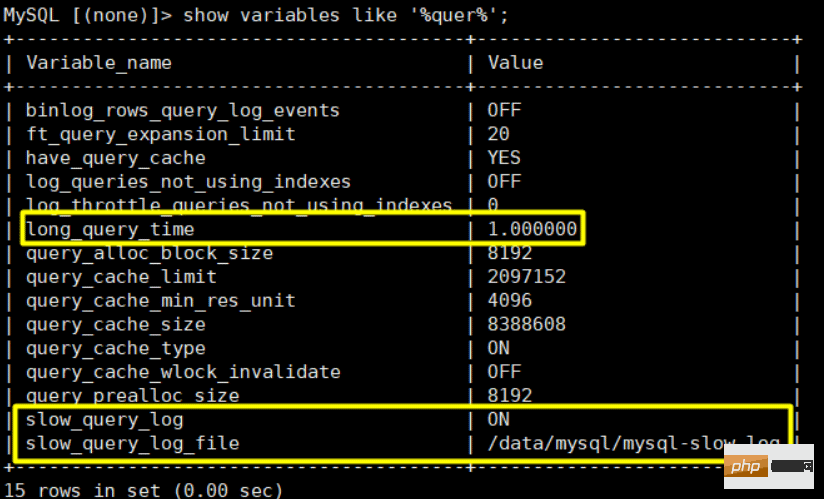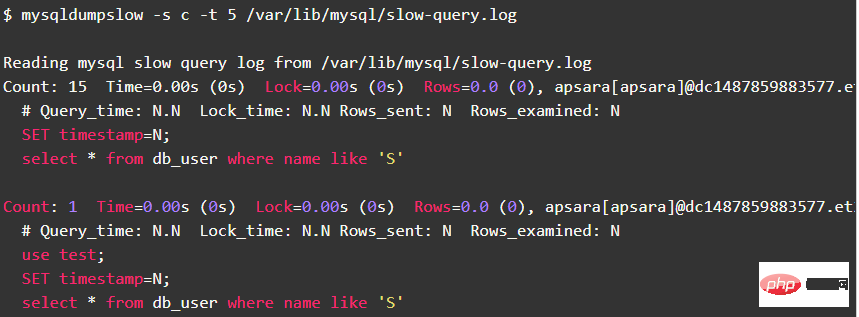show variables like 'log_output';
mysqldumpslow
MySQL slow query log practice (graphic and text analysis)
Recommended learning: mysql video tutorial
1. Overview
MySQL’s slow query log is provided by MySQL A kind of log record, which is used to record SQL statements whose response time exceeds the threshold (long_query_time, unit: seconds) in MySQL. By default, MySQL does not start slow query logging. This article briefly introduces how to enable slow query logs and how to use mysqldumpslow to analyze slow queries.
2. Slow query log settings
1. Temporary settings
Temporarily enable the slow query log (failed after restarting)
set global slow_query_log = on;

Note: If you want to turn off the slow query log, you only need to execute set global slow_query_log = off;.
Temporary slow query time critical point Query times higher than this critical point will be recorded in the slow query log (restart failure)
set long_query_time = 1;

Set slow Query storage method (invalid after restart)
set global log_output = file;

Explanation: As you can see, I set it to file here, which means that my slow query log is It is reflected by file. The default is none. We can set it to table or file. If it is table, the slow query information will be saved to the slow_log table under the mysql library.
2. Query the opening status of the slow query log and the storage location of the slow query log
show variables like '%quer%';

##Parameter description:
- slow_query_log: Whether slow query has been enabled
- slow_query_log_file: Slow query log file path
- long_query_time: Queries that exceed the number of seconds are written to the log
show variables like 'log_output';
Copy after login
show variables like 'log_output';

[mysqld]slow_query_log= 1slow_query_log_file= /var/lib/mysql/slow-query.log # 若没有指定,默认名字为hostname_slow.loglong_query_time= 1log_queries_not_using_indexes= 1
Create a slow query and execute it. As follows:
mysql> select sleep(1);+----------+ | sleep(1) | +----------+ | 0 | +----------+ 1 row in set (1.00 sec)

mysqldumpslow
Copy after login
mysqldumpslow is MySQL’s own tool for analyzing slow queries. The tool is a Perl script. mysqldumpslow
Commonly used parameters are as follows:
- -s: Sort method, the value is as follows
- c: Number of queries
- t:Query time
- l:Lock time
- r:Return records
- ac:Average number of queries
- al:Average lock time
- ar:Average return record book
- at:Average query time
- -t:topN query
- -g :Regular expression
Get the 5 most visited SQL statements:

$ mysqldumpslow -s t -t 5 /var/lib/mysql/slow-query.log
$ mysqldumpslow -s t -t 3 -g "like" /var/lib/mysql/slow-query.log
五、MySQL 清理slowlog方法
SET GLOBAL slow_query_log = 'OFF'; ALTER TABLEmysql.slow_log RENAME mysql.slow_log_drop; CREATE TABLE mysql.slow_log LIKEmysql.slow_log_drop; SET GLOBAL slow_query_log = 'ON'; DROP TABLE mysql.slow_log_drop;
推荐学习:mysql视频教程
The above is the detailed content of MySQL slow query log practice (graphic and text analysis). For more information, please follow other related articles on the PHP Chinese website!

Hot AI Tools

Undresser.AI Undress
AI-powered app for creating realistic nude photos

AI Clothes Remover
Online AI tool for removing clothes from photos.

Undress AI Tool
Undress images for free

Clothoff.io
AI clothes remover

Video Face Swap
Swap faces in any video effortlessly with our completely free AI face swap tool!

Hot Article

Hot Tools

Notepad++7.3.1
Easy-to-use and free code editor

SublimeText3 Chinese version
Chinese version, very easy to use

Zend Studio 13.0.1
Powerful PHP integrated development environment

Dreamweaver CS6
Visual web development tools

SublimeText3 Mac version
God-level code editing software (SublimeText3)

Hot Topics
 1664
1664
 14
14
 1422
1422
 52
52
 1316
1316
 25
25
 1268
1268
 29
29
 1240
1240
 24
24
 MySQL's Role: Databases in Web Applications
Apr 17, 2025 am 12:23 AM
MySQL's Role: Databases in Web Applications
Apr 17, 2025 am 12:23 AM
The main role of MySQL in web applications is to store and manage data. 1.MySQL efficiently processes user information, product catalogs, transaction records and other data. 2. Through SQL query, developers can extract information from the database to generate dynamic content. 3.MySQL works based on the client-server model to ensure acceptable query speed.
 Laravel Introduction Example
Apr 18, 2025 pm 12:45 PM
Laravel Introduction Example
Apr 18, 2025 pm 12:45 PM
Laravel is a PHP framework for easy building of web applications. It provides a range of powerful features including: Installation: Install the Laravel CLI globally with Composer and create applications in the project directory. Routing: Define the relationship between the URL and the handler in routes/web.php. View: Create a view in resources/views to render the application's interface. Database Integration: Provides out-of-the-box integration with databases such as MySQL and uses migration to create and modify tables. Model and Controller: The model represents the database entity and the controller processes HTTP requests.
 MySQL and phpMyAdmin: Core Features and Functions
Apr 22, 2025 am 12:12 AM
MySQL and phpMyAdmin: Core Features and Functions
Apr 22, 2025 am 12:12 AM
MySQL and phpMyAdmin are powerful database management tools. 1) MySQL is used to create databases and tables, and to execute DML and SQL queries. 2) phpMyAdmin provides an intuitive interface for database management, table structure management, data operations and user permission management.
 MySQL vs. Other Programming Languages: A Comparison
Apr 19, 2025 am 12:22 AM
MySQL vs. Other Programming Languages: A Comparison
Apr 19, 2025 am 12:22 AM
Compared with other programming languages, MySQL is mainly used to store and manage data, while other languages such as Python, Java, and C are used for logical processing and application development. MySQL is known for its high performance, scalability and cross-platform support, suitable for data management needs, while other languages have advantages in their respective fields such as data analytics, enterprise applications, and system programming.
 Solve database connection problem: a practical case of using minii/db library
Apr 18, 2025 am 07:09 AM
Solve database connection problem: a practical case of using minii/db library
Apr 18, 2025 am 07:09 AM
I encountered a tricky problem when developing a small application: the need to quickly integrate a lightweight database operation library. After trying multiple libraries, I found that they either have too much functionality or are not very compatible. Eventually, I found minii/db, a simplified version based on Yii2 that solved my problem perfectly.
 Laravel framework installation method
Apr 18, 2025 pm 12:54 PM
Laravel framework installation method
Apr 18, 2025 pm 12:54 PM
Article summary: This article provides detailed step-by-step instructions to guide readers on how to easily install the Laravel framework. Laravel is a powerful PHP framework that speeds up the development process of web applications. This tutorial covers the installation process from system requirements to configuring databases and setting up routing. By following these steps, readers can quickly and efficiently lay a solid foundation for their Laravel project.
 MySQL for Beginners: Getting Started with Database Management
Apr 18, 2025 am 12:10 AM
MySQL for Beginners: Getting Started with Database Management
Apr 18, 2025 am 12:10 AM
The basic operations of MySQL include creating databases, tables, and using SQL to perform CRUD operations on data. 1. Create a database: CREATEDATABASEmy_first_db; 2. Create a table: CREATETABLEbooks(idINTAUTO_INCREMENTPRIMARYKEY, titleVARCHAR(100)NOTNULL, authorVARCHAR(100)NOTNULL, published_yearINT); 3. Insert data: INSERTINTObooks(title, author, published_year)VA
 Solve MySQL mode problem: The experience of using the TheliaMySQLModesChecker module
Apr 18, 2025 am 08:42 AM
Solve MySQL mode problem: The experience of using the TheliaMySQLModesChecker module
Apr 18, 2025 am 08:42 AM
When developing an e-commerce website using Thelia, I encountered a tricky problem: MySQL mode is not set properly, causing some features to not function properly. After some exploration, I found a module called TheliaMySQLModesChecker, which is able to automatically fix the MySQL pattern required by Thelia, completely solving my troubles.





